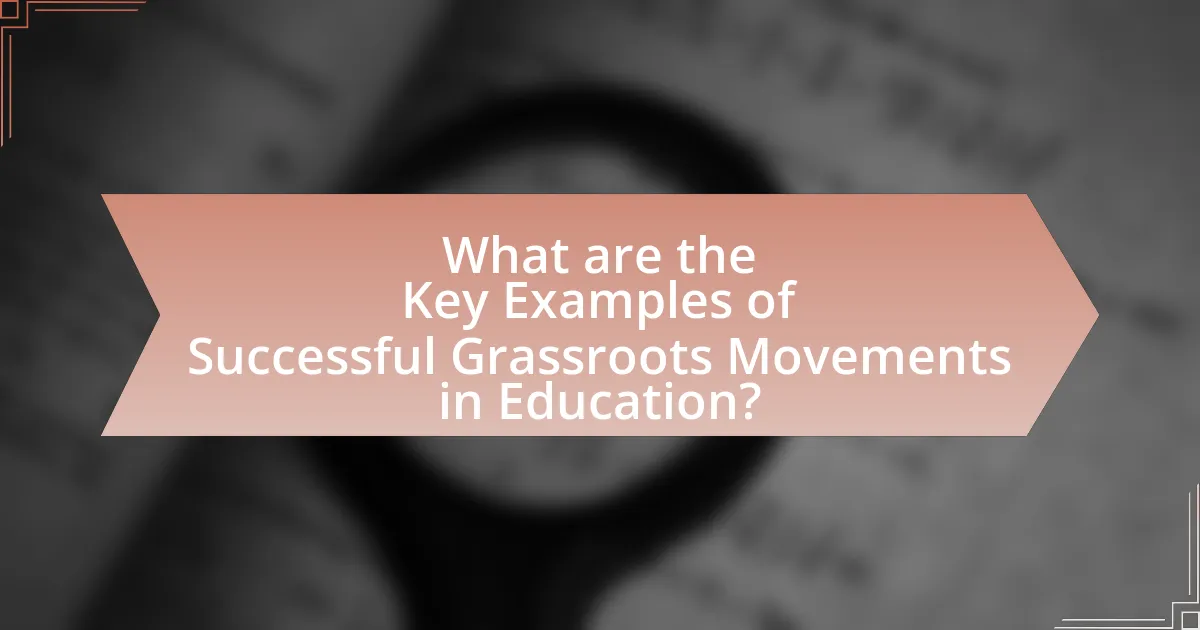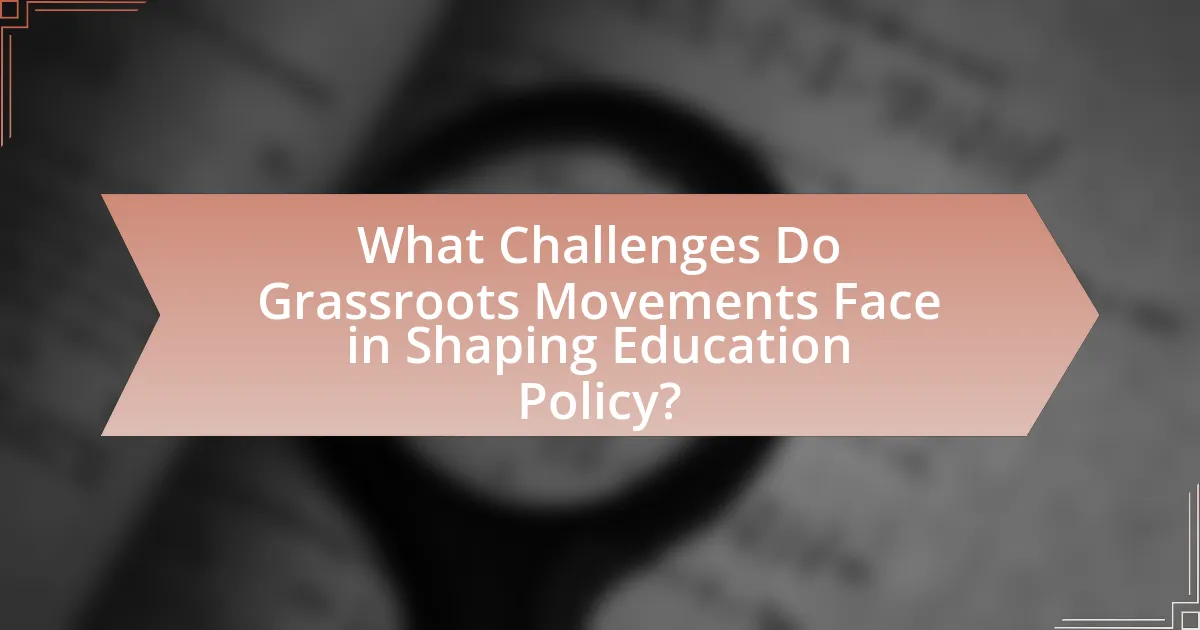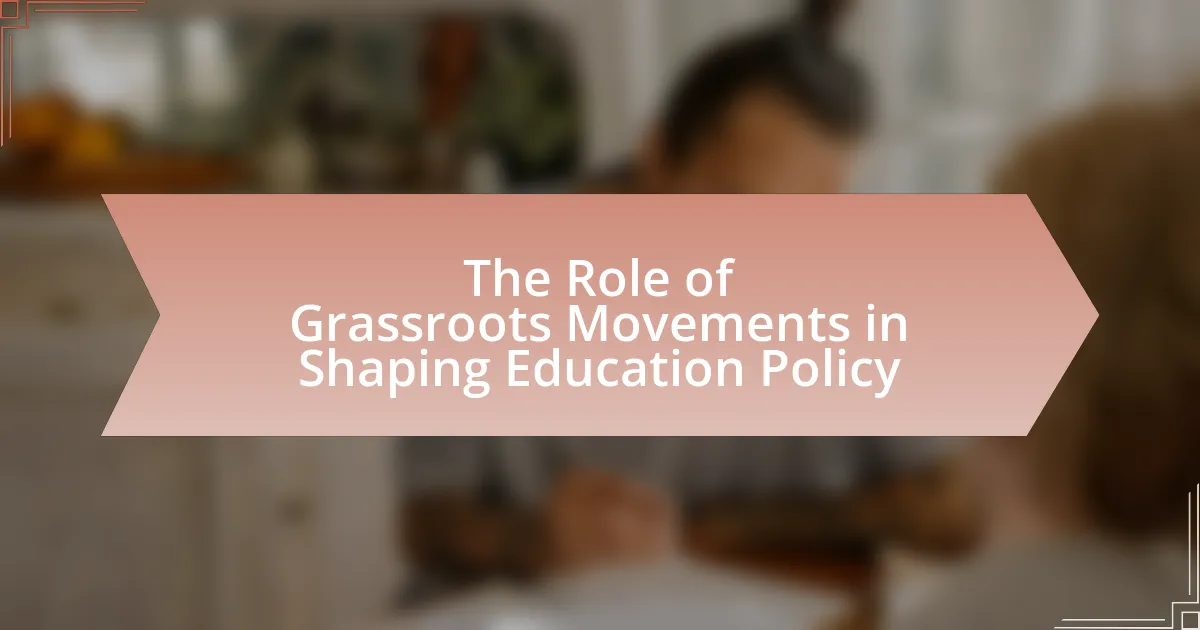Grassroots movements are collective efforts by community members advocating for change in education policy, emphasizing the importance of local voices in shaping equitable educational practices. This article explores how grassroots movements influence education policy decisions through community organizing, advocacy campaigns, and coalition building, highlighting successful examples such as the Chicago Teachers Union strike and the “Save Our Schools” movement. It also examines the challenges these movements face, including limited resources and political opposition, while discussing strategies for effective advocacy and the critical role of community engagement in achieving educational reforms.

What are Grassroots Movements and Their Importance in Education Policy?
Grassroots movements are collective efforts by individuals at the community level to advocate for change, often focusing on social, political, or educational issues. In the context of education policy, these movements play a crucial role by mobilizing parents, teachers, and community members to influence decision-makers and promote reforms that reflect the needs and values of the community. For instance, the Chicago Teachers Union’s strike in 2012 highlighted issues such as class size and funding, demonstrating how grassroots activism can lead to significant policy changes. Such movements empower marginalized voices, ensuring that education policies are more equitable and responsive to local needs.
How do grassroots movements influence education policy decisions?
Grassroots movements influence education policy decisions by mobilizing community members to advocate for specific changes, thereby amplifying local voices in the policymaking process. These movements often organize campaigns, rallies, and petitions that draw attention to educational issues, such as funding disparities or curriculum reforms. For instance, the “Save Our Schools” movement in the United States successfully raised awareness about the negative impacts of standardized testing and led to policy discussions at local and state levels. Research indicates that grassroots advocacy can lead to significant policy shifts; a study by the National Education Association found that grassroots efforts contributed to the passage of legislation increasing funding for public schools in several states.
What strategies do grassroots movements employ to effect change in education policy?
Grassroots movements employ strategies such as community organizing, advocacy campaigns, coalition building, and leveraging social media to effect change in education policy. Community organizing involves mobilizing local stakeholders to identify issues and develop collective solutions, which can lead to increased awareness and pressure on policymakers. Advocacy campaigns focus on raising public awareness and influencing decision-makers through targeted messaging and lobbying efforts. Coalition building brings together diverse groups to amplify their voices and create a unified front, enhancing their impact on policy discussions. Additionally, leveraging social media allows grassroots movements to reach wider audiences, share information rapidly, and engage supporters in real-time, thereby increasing their influence on education policy.
How do grassroots movements mobilize community support for education reforms?
Grassroots movements mobilize community support for education reforms by fostering local engagement and building coalitions among stakeholders. These movements often utilize strategies such as organizing community meetings, leveraging social media for outreach, and creating awareness campaigns that highlight the need for specific reforms. For instance, the “Save Our Schools” movement in the United States effectively rallied parents, teachers, and community members to advocate for equitable funding and policy changes, demonstrating the power of collective action. Research indicates that grassroots efforts can lead to significant policy shifts, as seen in the successful implementation of the “Community Schools” model in various districts, which emphasizes local input and collaboration.
Why are grassroots movements essential for equitable education?
Grassroots movements are essential for equitable education because they empower marginalized communities to advocate for their educational rights and needs. These movements often arise from local concerns and directly address systemic inequalities in education, such as funding disparities and access to resources. For instance, the “Black Lives Matter at School” movement has highlighted the need for anti-racist curricula and equitable funding, demonstrating how grassroots activism can influence policy changes at local and national levels. Research shows that when communities mobilize, they can effectively challenge inequitable practices and push for reforms that promote inclusivity and fairness in education.
What role do grassroots movements play in advocating for marginalized communities in education?
Grassroots movements play a crucial role in advocating for marginalized communities in education by mobilizing local voices to influence policy changes and promote equitable access to resources. These movements often arise from the communities themselves, allowing individuals to articulate their specific needs and challenges, which traditional educational institutions may overlook. For instance, organizations like the Black Lives Matter movement have highlighted systemic inequalities in education, leading to increased awareness and policy reforms aimed at addressing disparities in funding and support for schools in underserved areas. Additionally, grassroots efforts have successfully organized campaigns that demand inclusive curricula and culturally relevant teaching practices, thereby fostering an educational environment that respects and reflects the diversity of student populations.
How do grassroots movements address systemic inequalities in education policy?
Grassroots movements address systemic inequalities in education policy by mobilizing communities to advocate for equitable access to resources and representation in decision-making processes. These movements often highlight disparities in funding, curriculum, and support services that disproportionately affect marginalized groups. For instance, the Black Lives Matter at School movement emphasizes the need for anti-racist curricula and equitable funding, demonstrating how grassroots advocacy can lead to policy changes that address historical injustices in education. Research shows that grassroots efforts can effectively influence local and state education policies, as seen in the successful campaigns for increased funding in under-resourced schools, which often arise from community-led initiatives.

What are the Key Examples of Successful Grassroots Movements in Education?
Key examples of successful grassroots movements in education include the Chicago Teachers Union strike in 2012, which advocated for better working conditions and equitable funding, resulting in significant policy changes. Another example is the “Save Our Schools” movement, which emerged in 2011 to oppose high-stakes testing and promote public education, influencing national conversations about education reform. Additionally, the “Parents Across America” initiative has mobilized parents to advocate for equitable education policies, impacting local and state education systems. These movements demonstrate the power of collective action in shaping educational policy and reform.
What notable grassroots movements have shaped education policy in recent years?
Notable grassroots movements that have shaped education policy in recent years include the Black Lives Matter at School movement and the #RedForEd campaign. The Black Lives Matter at School movement advocates for racial justice in education, promoting curriculum changes and policies that address systemic racism, which has gained traction in various school districts across the United States. The #RedForEd campaign, initiated by educators in Arizona, emphasizes the need for increased funding for public education and better teacher salaries, leading to significant policy changes in several states, including Arizona and West Virginia. These movements have mobilized communities, influenced legislative discussions, and resulted in tangible reforms in education policy.
How did the “Parents for Public Schools” movement impact local education policies?
The “Parents for Public Schools” movement significantly influenced local education policies by advocating for increased parental involvement and accountability in public schools. This grassroots initiative led to the establishment of policies that emphasized community engagement, transparency, and responsiveness to parents’ concerns. For instance, the movement successfully pushed for reforms that included the creation of parent advisory councils and enhanced communication between schools and families, which resulted in improved educational outcomes and greater public trust in local school systems.
What lessons can be learned from the “Teach for America” grassroots initiative?
The “Teach for America” grassroots initiative demonstrates the importance of mobilizing individuals to address educational inequities. This initiative highlights that grassroots movements can effectively recruit and train passionate individuals to teach in underserved communities, thereby directly impacting student achievement. Evidence from studies indicates that participants in the program often remain committed to educational reform, influencing policy discussions and advocating for systemic changes in education. Furthermore, the initiative underscores the value of community engagement and collaboration, as local stakeholders are essential in identifying needs and implementing solutions tailored to specific contexts.
How do grassroots movements collaborate with other stakeholders in education?
Grassroots movements collaborate with other stakeholders in education by forming coalitions that include parents, teachers, community organizations, and policymakers to advocate for systemic change. These collaborations often involve organizing community meetings, conducting research to highlight educational disparities, and mobilizing public support for policy reforms. For instance, the Alliance to Reclaim Our Schools, a coalition of grassroots organizations, has successfully influenced local education policies by uniting various stakeholders around common goals, demonstrating the effectiveness of collective action in shaping educational outcomes.
What partnerships are formed between grassroots movements and educational institutions?
Grassroots movements often form partnerships with educational institutions to advocate for policy changes, enhance community engagement, and promote social justice in education. These collaborations can include joint initiatives for curriculum development that reflect community needs, co-hosting workshops and seminars to raise awareness about educational disparities, and engaging in research projects that highlight the impact of systemic issues on student outcomes. For instance, the partnership between the Black Lives Matter movement and various universities has led to the incorporation of anti-racist curricula and community-based learning programs, demonstrating the effectiveness of such alliances in influencing educational practices and policies.
How do grassroots movements engage with policymakers to influence education reform?
Grassroots movements engage with policymakers to influence education reform primarily through advocacy, mobilization, and coalition-building. These movements often organize community members to raise awareness about specific educational issues, such as funding disparities or curriculum changes, thereby creating a collective voice that policymakers cannot ignore. For instance, the “Save Our Schools” movement in the United States effectively mobilized parents and educators to advocate for equitable funding, resulting in legislative discussions around education finance reform. Additionally, grassroots organizations frequently utilize data and research to support their claims, presenting evidence-based arguments to policymakers, which enhances their credibility and impact. This strategic engagement not only informs policymakers about the needs and perspectives of the community but also pressures them to consider reforms that align with grassroots demands.

What Challenges Do Grassroots Movements Face in Shaping Education Policy?
Grassroots movements face significant challenges in shaping education policy, primarily due to limited resources and institutional resistance. These movements often operate with minimal funding and manpower, which restricts their ability to effectively mobilize support and influence decision-makers. Additionally, established educational institutions and policymakers may resist changes proposed by grassroots initiatives, viewing them as disruptive or lacking legitimacy. For instance, a study by the National Education Association highlights that grassroots efforts often struggle to gain traction against well-funded lobbying groups that represent entrenched interests in education. This combination of resource constraints and institutional pushback makes it difficult for grassroots movements to enact meaningful policy changes in the education sector.
What obstacles hinder the effectiveness of grassroots movements in education?
Grassroots movements in education face several obstacles that hinder their effectiveness, including lack of funding, insufficient organizational structure, and resistance from established institutions. Limited financial resources restrict the ability of these movements to mobilize support, conduct outreach, and implement initiatives. Additionally, many grassroots organizations lack a formalized structure, which can lead to inefficiencies and difficulties in coordination. Resistance from established educational institutions and policymakers often manifests as skepticism or outright opposition, making it challenging for grassroots movements to influence policy changes. These factors collectively impede the potential impact of grassroots efforts in shaping educational policy.
How does funding affect the sustainability of grassroots movements?
Funding significantly impacts the sustainability of grassroots movements by providing essential resources for operations, outreach, and advocacy efforts. Without adequate funding, grassroots movements struggle to maintain momentum, engage their communities, and influence policy effectively. For instance, a study by the National Committee for Responsive Philanthropy found that organizations with stable funding are more likely to achieve long-term goals and create systemic change, highlighting the correlation between financial support and movement longevity. Additionally, funding enables grassroots movements to hire staff, organize events, and develop campaigns, which are critical for sustaining engagement and driving policy reform in education.
What role does political opposition play in the challenges faced by grassroots movements?
Political opposition significantly complicates the challenges faced by grassroots movements by undermining their objectives and mobilization efforts. Grassroots movements often encounter resistance from established political entities that may view their initiatives as threats to the status quo, leading to legislative pushback, public discrediting, or resource allocation aimed at stifling their influence. For instance, in the context of education policy, grassroots movements advocating for reforms may face opposition from political groups aligned with traditional educational institutions, which can result in policies that favor existing power structures over innovative changes proposed by grassroots advocates. This dynamic illustrates how political opposition can create barriers to progress, limit funding opportunities, and diminish public support, ultimately hindering the effectiveness of grassroots movements in shaping education policy.
How can grassroots movements overcome these challenges?
Grassroots movements can overcome challenges by building strong coalitions and leveraging community engagement. By uniting diverse stakeholders, these movements can amplify their voices and create a more significant impact on education policy. For instance, the successful campaign for the Chicago Teachers Union in 2012 demonstrated how collective action and community support can lead to substantial policy changes, such as improved funding and resources for schools. Additionally, utilizing social media platforms allows grassroots movements to disseminate information quickly, mobilize supporters, and raise awareness about educational issues, as seen in the #RedForEd movement, which effectively organized teachers across multiple states to advocate for better pay and funding.
What strategies can grassroots movements adopt to enhance their impact on education policy?
Grassroots movements can enhance their impact on education policy by employing strategies such as building coalitions, leveraging social media for awareness, and engaging in direct advocacy. Building coalitions with other organizations amplifies their voice and resources, as seen in the successful collaboration of various education advocacy groups in the “Save Our Schools” movement, which effectively influenced policy changes in multiple states. Leveraging social media platforms allows grassroots movements to reach a wider audience, mobilize supporters, and disseminate information rapidly, exemplified by the viral campaigns that have raised awareness about educational inequities. Engaging in direct advocacy, including lobbying local and state legislators, enables grassroots movements to present their demands and influence decision-makers directly, as demonstrated by the numerous town hall meetings organized by grassroots activists to discuss education reforms.
How can grassroots movements build resilience in the face of adversity?
Grassroots movements can build resilience in the face of adversity by fostering community solidarity and mobilizing collective action. These movements often create networks of support that empower individuals to share resources, knowledge, and strategies for overcoming challenges. For instance, during the 2011 Wisconsin protests against budget cuts to education, grassroots organizations united educators, students, and community members, demonstrating how collective efforts can amplify voices and influence policy decisions. This collaborative approach not only strengthens the movement but also enhances the community’s ability to withstand external pressures and setbacks.
What Best Practices Can Grassroots Movements Implement for Effective Advocacy?
Grassroots movements can implement best practices such as building strong community coalitions, utilizing social media for outreach, and engaging in direct lobbying to enhance their advocacy efforts. Strong community coalitions foster collaboration and amplify voices, as seen in the successful coalition-building efforts of the Alliance for Educational Justice, which united various organizations to advocate for equitable education policies. Utilizing social media allows grassroots movements to reach wider audiences quickly; for instance, the #BlackLivesMatter movement effectively mobilized support and awareness through platforms like Twitter and Instagram. Direct lobbying, as demonstrated by the grassroots organization ParentsTogether, enables movements to influence policymakers directly by presenting organized, community-driven demands. These practices collectively strengthen the impact of grassroots advocacy in shaping education policy.
How can grassroots movements effectively communicate their goals to the public?
Grassroots movements can effectively communicate their goals to the public by utilizing clear messaging, leveraging social media platforms, and engaging in community outreach. Clear messaging ensures that the objectives are easily understood, which is crucial for garnering public support. For instance, the Black Lives Matter movement has successfully used concise slogans and hashtags to convey its mission, making complex issues accessible to a broader audience.
Social media platforms serve as powerful tools for grassroots movements, allowing them to reach large audiences quickly and efficiently. According to a study by the Pew Research Center, 69% of adults in the U.S. use social media, making it an effective channel for disseminating information and mobilizing supporters.
Community outreach, including town hall meetings and local events, fosters direct engagement with the public, allowing grassroots movements to build relationships and trust. Research from the Harvard Kennedy School highlights that face-to-face interactions significantly enhance community involvement and support for grassroots initiatives.
What role does community engagement play in the success of grassroots movements?
Community engagement is crucial for the success of grassroots movements as it fosters collective action and mobilizes resources. When individuals within a community actively participate, they contribute diverse perspectives and skills, enhancing the movement’s effectiveness. For instance, the 2011 Occupy Wall Street movement gained momentum through local assemblies that encouraged community involvement, leading to widespread awareness and support for economic inequality issues. Additionally, research by the Stanford Social Innovation Review indicates that grassroots movements with strong community ties are more likely to achieve their goals, as they build trust and solidarity among participants, which is essential for sustained advocacy and policy change.


